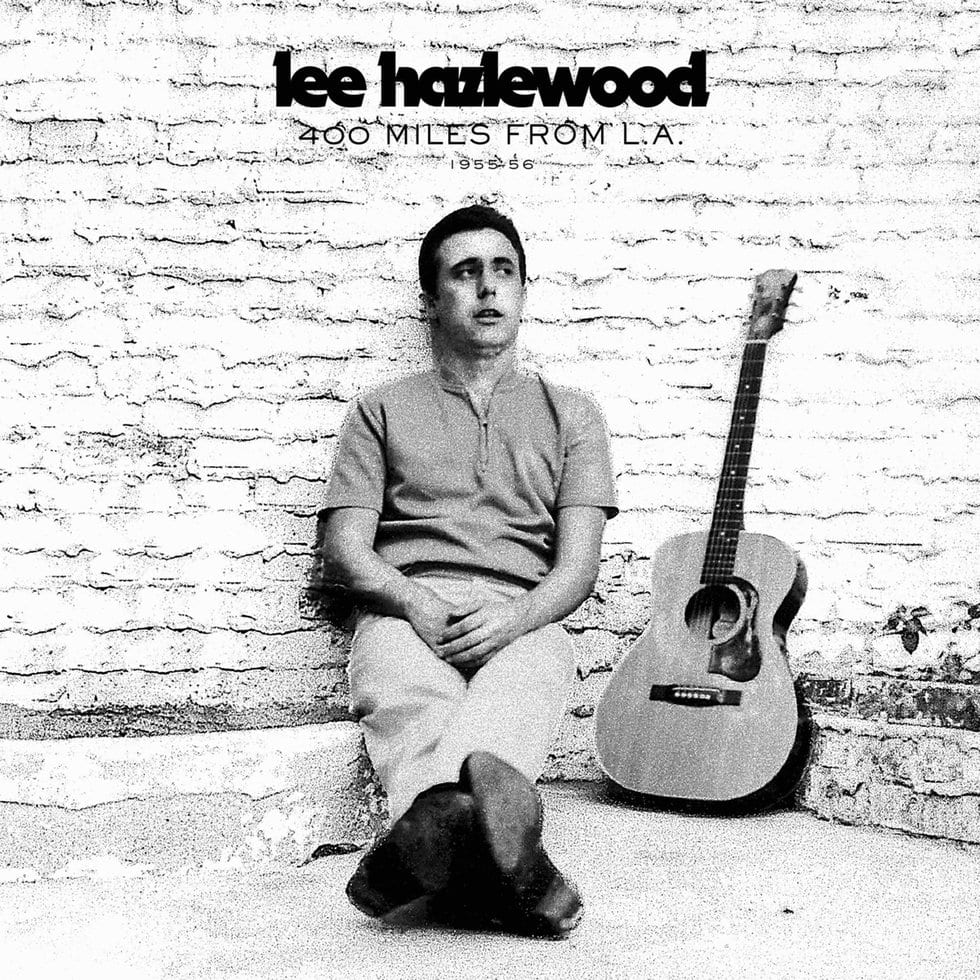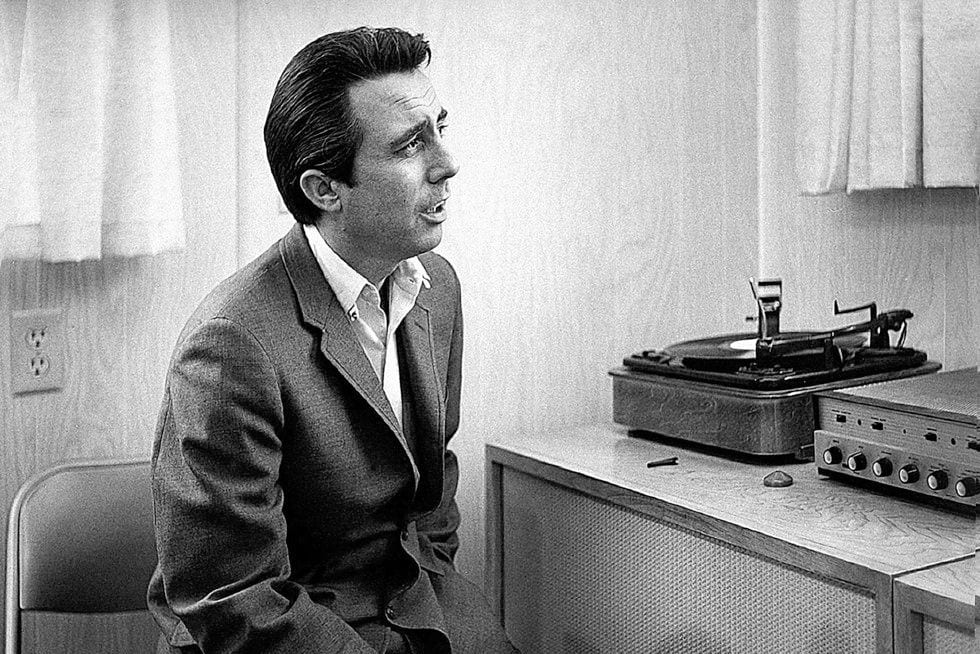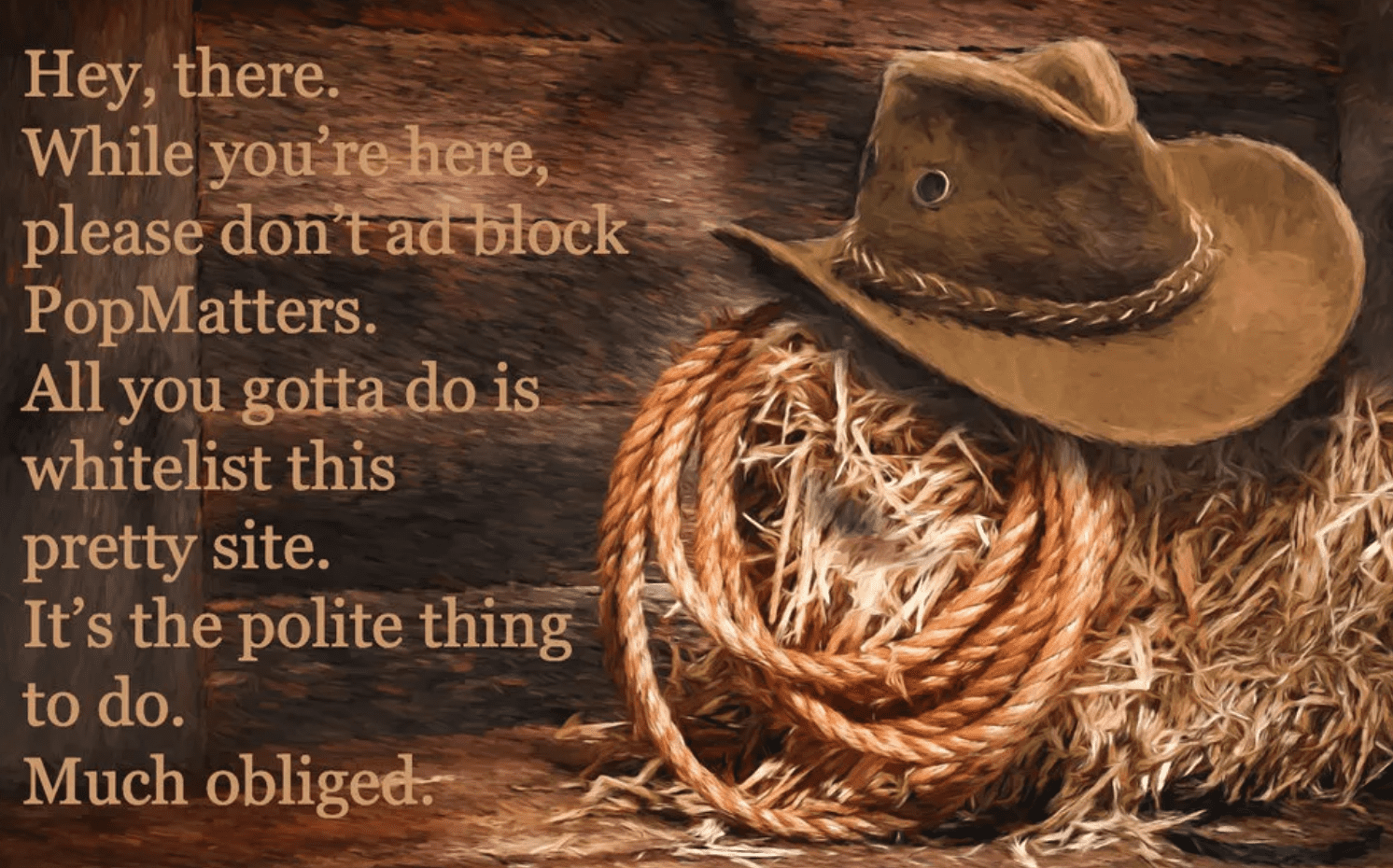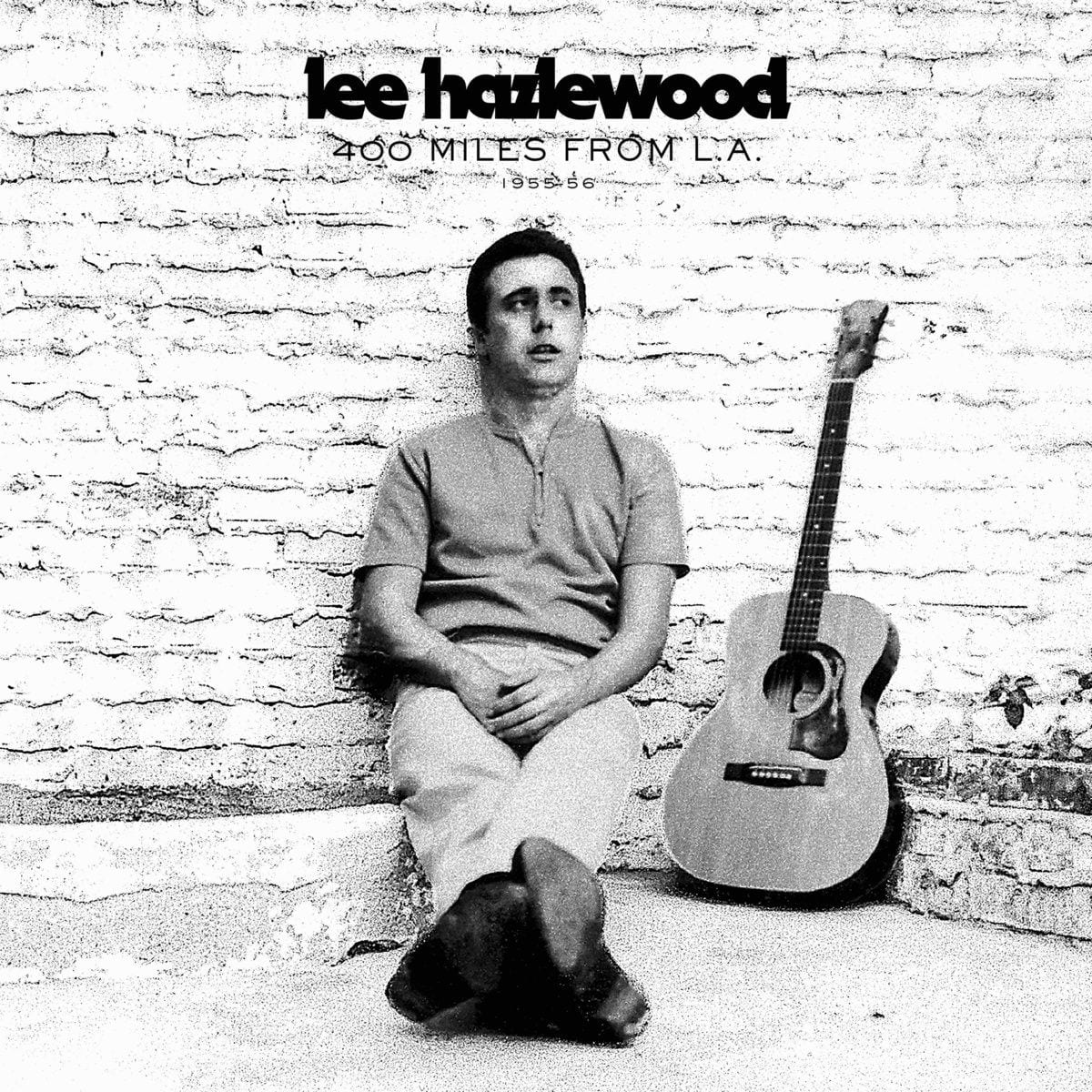
Light in the Attic continue their expansive Lee Hazlewood series with 400 Miles From L.A. 1955-56. This latest deluxe package features a series of recordings previously unknown to Hazlewood fanatics. The material was tracked in Phoenix, Arizona, during a time when the budding artist was honing his craft and his voice, a time during which he would often shuttle between Phoenix and Los Angeles with the hopes of landing a hit song. It would take him a decade before Nancy Sinatra would chart with “These Boots Are Made For Walking”. His taste of wide commercial success was, of course, short-lived.
By the end of the 1960s, Hazlewood was done with Los Angeles, even if he wasn’t done with the music business. He traveled to Sweden and made some of his most potent and personal albums, including Requiem For an Almost Lady and A House Safe For Tigers. These records were all but forgotten until the Light in the Attic campaign began over a decade ago and, according to Hazlewood expert, Hunter Lea, they might have stayed lost had the musician had his way.
In an extensive chat with PopMatters, Lea details Hazlewood’s ascent to underground favorite late in his life and a reluctance to embrace his prolific and truly remarkable past. “He thought people were trying to rip him off,” Lea recalls. Across the years, Lea and the team have undertaken the task of not only reissuing those past LPs but attempting to find previously unheard Hazlewood compositions.
400 Miles From L.A. features unexpected finds, believed now to be the earliest recordings that Hazlewood had undertaken, including an early sketch for what would become his first proper album, 1963’s Trouble Is a Lonesome Town.The finished LP is an early example of a concept album and the demos reveal not only the reach of Hazlewood’s imagination but also his focus.
Cowboy hat & lasso by jimo663 (Pixabay License / Pixabay)
Though he was prone, as Lea points out, to refer to his recordings as demos (even in their most finished state), the material sounds remarkably complete and suggests that Hazlewood’s singular vocal and writing style were intact from the start. More than 60 years after he committed it to tape, there’s still no song quite like “Cross Country Bus” in the larger body of American music. “Five Thousand and One” serves as a portrait of a bull in the bullfighting arena. If it’s not the only song to take on that subject matter, it’s probably in a niche category, to say the least.
The songs that would comprise Trouble Is a Lonesome Town easily sound as though they could have emerged in contemporary times. There’s an understated quality that feels like any one of hundreds of albums tracked in suburban bedrooms across the continent today. Although the genre of concept albums would proliferate in the decades after this material was initially conceived, there also remains nothing quite like “Long Black Train”, “Big Joe Slade”, and “Georgia Chain Gang”.
For those who have long been fascinated by the name Lee Hazlewood but who have, for one reason or another, put off diving into the full discography, 400 Miles From L.A. is an excellent place to begin. It’s intimate in ways that some later recordings are and are not. The album carries a beginner’s focus and determination, and the spare way in which the songs are rendered is as moving as it is impressive.
Lea spoke with PopMatters from his home in Washington state about Hazlewood’s legacy, missing links and hopes for future projects. Lea provides the liner notes for 400 Miles From L.A., with an interview from Arizona music historian and producer John Dixon. As always, the collection features archival photos and ephemera.
Where was Lee Hazlewood in his life when he made these recordings?
Lee had been in the army and served in the Korean War. When he got out, he took advantage of the G.I. Bill and went to broadcast school in California. After he graduated, he needed a job, and the closest radio job he could find was in Arizona. The missing piece of the puzzle is that I don’t know why Lee started writing songs. He was a creative guy, a good writer in lots of different mediums, but songs were something else. I suspect that becoming a DJ, he figured, “Hell, I can do this. It isn’t tough. These songs are only a few chords.”
Then he started Viv Records.
He met a bunch of local Phoenix artists, including Al Casey, who was later in the Wrecking Crew. Around that time, 1954, ’55, ’56, he had no hits. He was just a DJ who ran a record label out of his garage. So, flash forward: John Dixon bought all the Viv Records stash. All the leftover 78s, 45s, all the tapes. He had that all for years and thought it had all been released before.
The tapes from John Dixon got to the guy who owns Bear Family [Richard Weize], and on the tapes, there were hours and hours of music. No one had gone through every tape fully, and they weren’t marked well. What was on there included basically two lost Lee Hazlewood albums.
Incredible.
We all know his first album as Trouble Is a Lonesome Town from 1963. We found these two albums that are basically demos, but Lee considered all his albums demos in a way. He never thought he was a good enough singer. On these two tapes, one was the earliest known recordings of Lee singing his own songs. The second was a full run-through of Trouble Is a Lonesome Town, a full recording with Arizona musicians and not in L.A. with the Wrecking Crew.
What was it like for you to hear this material for the first time?
It was incredible because it totally re-wrote Lee’s recorded history. He was about 25 on these recordings, singing on a primitive reel-to-reel, but everything is there. His voice is there. He’s writing great songs. He’s fully-formed. I was blown away that he had this concept record that early. Even 1963 is early for a concept record. But in 1955?
There’s really something singular about Lee’s voice and his writing. He’s like Leonard Cohen in that way. Did he meet resistance because of that?
At the point that he’s making these recordings, I don’t think that he even considered himself an artist. Even until the mid-1960s, he called everything he sang on demos. I don’t know if that was some sort of defense mechanism because he didn’t think he was a great singer. My understanding is that he took these tapes, got on a bus, and went to Los Angeles. Then he pitched these tapes as a songwriter. I don’t know how many trips he made, but he never had any success when he took the tapes to L.A. There was even a guy who said, “Lee, I love you, but you’ve got to find another line of work. Songwriting and recording just aren’t for you.” I think he was just a little early.
Photo: Courtesy of Light in the Attic Records
The music is and isn’t of its time.
It could have been recorded in any era. That’s the magic of it. It could have been recorded now because it’s just a guy with an acoustic guitar doing a demo.
What was your introduction to Lee Hazlewood’s music?
It was my senior year of high school, 2001. I was reading interviews in Mojo , and other magazines and Beck and Jarvis Cocker kept name-dropping this guy Lee Hazlewood. Once I’d heard his name about five times, I said, “I’ve got to look this guy up.” Steve Shelley from Sonic Youth had this label called Smells Like Records. I went to the website and read about how much Steve loved Lee. There were about five albums available. I just started listening to song samples, and I thought, “This is amazing!”
It sounded like Mark Lanegan and Leonard Cohen, all these other cool baritone singers that I loved. The first record I ordered was 13,, which is a really weird one. It’s a funk/soul record but with this crazy subterranean baritone. The songs are weird, the lyrics are weird, but there’s so much swagger to them. I fell in love with his writing, and he became one of my favorite music-makers of all time because there’s not a lot of people like him.
When you came to his music in 2001, how much was out there for you to discover about him?
Not very much at all. I never met him. I really wanted to, but he died. I don’t know what his hang-up was, but it seemed really hard for people to convince him to let them put out his music. We’ve been doing this series for over ten years at Light in the Attic, but the series goes back further than that. In the early ’90s, one of our friends and collaborators, Mark Pickerel, the drummer from Screaming Trees, fell in love with Lee’s music. He was listening to that music in the ’80s.
I believe that Mark told Steve Fisk, the producer of those [early] Screaming Trees records, “There was this Lee and Nancy Sinatra record my parents had when I was a kid. I just love it.” Steve said, “Have you heard all of Lee’s solo records?” Mark had no idea. That started his quest and obsession.
It’s amazing when that happens.
Mark bought as many Lee records as he could find. He wanted to put them out on Sub Pop. Sub Pop was into it. They started faxing with him, and Lee wound up being difficult and a curmudgeon. He thought he was being swindled. He wondered why anyone would want to release all these songs that weren’t hits, that weren’t successful. He said, “My lawyers are watching you.” I think Mark had Nirvana, Mazzy Star, all these bands, willing to do a Lee tribute record. It would have been so great for him.
That would have been fantastic. That was happening at a time when some other writers from Lee’s era were seeing a resurgence of interest in their work.
It didn’t happen, and then Mark hooked up with Steve Shelley. I’m not sure what happened, but Lee eventually said, “You can reissue five of my records.” That gave him so many more listeners.
It’s funny to think that between grunge and avant-garde music, we now have Lee Hazlewood finding a new audience.
The drummer of Screaming Trees and the drummer of Sonic Youth made it happen. If you love older music, we’re living in this archival renaissance. A lot of stuff is becoming available online. Maybe it went under the radar. There’s an equalization.
What kicked off the Light in the Attic campaign?
I had a band called Mono In VCF that was playing a big music festival in Seattle, Bumbershoot. I think that was 2007. The bass player said, “There’s Matt from Light in the Attic Records! Go tell him to give our band a record deal!” I thought, “No, I’m not going to do that!” I did go up and introduce myself and tell him that I loved the label and that I thought he should put out Lee’s stuff.
I said, “He had this label called Lee Hazlewood Industries. There are hundreds of songs that aren’t online, not even on YouTube. There’s an amazing body of work that nobody’s even heard.” He said, “That’s interesting. Give me a call. We’ll see what happens.” We met up, got in touch with Mark, and he handed the torch off to us, and said, “Hey, I’d love to see this happen.”
Lee was still alive at this time.
He was. Matt tried to get a deal going, and we just got more resistance. Lee said, “When I’m dead and gone, my family can do whatever they want.” Then he passed away. We got a call from his widow, and she said, “I’d love for you to put some of this music out.” We got together with Mark and found Lee’s old girlfriend, Suzi Jane Hokom, who had started the label with him. In a way, she had discovered Gram Parsons and produced his album with the International Submarine Band. From there, a couple of other cool things happened for us.
Such as?
I talked to Steve Shelley about his experience with Lee. He said that for the album masters of the records he put out, Lee gave him a vinyl dub on a cassette, then they digitized the cassette. It was amazing to hear those records, but the fidelity wasn’t great. It sounded really rough, and I thought that that was how everything would sound.
When we started our project at Light in the Attic, through Lee’s publisher, we found this tape archive with over 500 pristine original ’60s master tapes. We’re still going through it.
Incredible.
We knew the records were going to sound great. We found a bunch of people who had worked with Lee. Matt asked me if I wanted to produce the first release, which was a compilation of the LHI era, 1966-1971. I had never done that before. Matt said, “You love Lee, and know everything about him.”
Talk to me about Requiem For an Almost Lady. It’s got a peculiarity to it that I love.
To me, that’s Lee’s greatest album. There’s no two ways about it. I’ve listened to all his records, a lot of his demos. There are pieces here and there where he opens up as a writer, but a lot of it is through characters. On Requiem For an Almost Lady, he speaks for himself. I think it’s really the only time that he ever did that, especially on a full album. There are songs here and there where he rips his heart out for you but not like he does there. It’s his purest and most heartfelt writing. I think that’s the greatest breakup record ever recorded because he had such a deep love for Suzi Jane.
This is around the start of the Swedish era, which is a strange chapter. You really couldn’t predict it.
In the mid-1960s, with LHI Records, he met Suzi Jane. She didn’t want to be a star. She wanted to be a producer. That fascinated him. She had copies of his first two albums. She had given him copies of 45s that she had made. They had mutual respect for each other. He started a relationship with someone who loved music as much as he did, who also loved producing. They started dating and formed this label together. They both produced a lot of stuff.
He’d had a huge hit with Nancy Sinatra. Everything was going so well for him. And then everything goes south. He has a little bit of a falling out with Nancy. He starts having problems with Suzi Jane. LHI has no hits. It’s expensive to record songs with the Wrecking Crew at the best studios in town and have a whole floor of an office building on the Sunset Strip, where the Beach Boys had their offices. He was living this larger-than-life experience.
Then it starts falling apart.
He was running out of money. Suddenly he had some hits in Sweden and started traveling there because of that. I think it was a great place for him to escape. He met Torbjorn Axelman, the director of Cowboy in Sweden. Torbjorn is the Swedish Lee. They became like brothers. He got to leave L.A. He recorded Requiem as a farewell. He made these records that only came out in Sweden or at best in Europe, and they went nowhere. He never had another hit.
Everything goes dark for a time.
A lot of ’60s songwriters only judge the quality of their songs based on their success. Lee considered “These Boots Are Made For Walking” a great song because it was a hit. But songs that went nowhere, he considered bad songs. They weren’t bad songs; they just didn’t have chart success at the time. He made records until about ’77. It fizzled out until the early ’90s.
What’s the Holy Grail for you when it comes to Lee’s music?
I would love to go to Sweden and search for a tape archive because he recorded there for about ten years. No one seems to know much about what he did there. I think we could find a ton of unreleased stuff. I’d like to make the pilgrimage with Light in the Attic.




